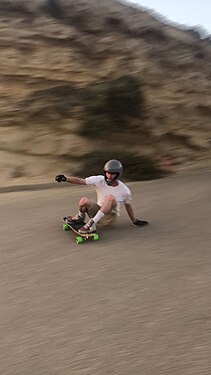
Longboarding is a variation of skateboarding typified by the use of longer boards ("decks") with longer wheelbases and softer wheels. While longboards vary widely in shape and size, compared to street skateboards longboards are designed to be more stable at speed and to have more traction due to larger wheel sizes and softer wheel durometers. While standard street skateboards may typically be between 28 and 34 inches long, longboards can range anywhere from 32 to 50 inches in length. Ride characteristics of longboards generally differ from that of street skateboards due to the use of specialized longboard trucks that have different properties than those typically used with skateboards; while street skateboards use "traditional kingpin" (TKP) trucks that are optimized for tight turning radii, ollie and flip tricks, slides, grinds, and transition skating, longboards are typically paired with "reverse kingpin" (RKP) trucks that are designed for increased stability at higher speeds, more "surfy" carving characteristics, and/or greater ride comfort for commuting over longer distances.
The term "longboarding" encompasses multiple disciplines. These include downhill/race, freeride, freestyle, dance, and long-distance pushing (LDP). Longboarding's disciplines vary significantly in terms of physical requirements, intensity/impact, risk, and intended user base. While it is not altogether uncommon for riders to practice multiple variations of longboarding, there are dedicated communities for downhill and freeride, freestyle and dance, and long-distance push.